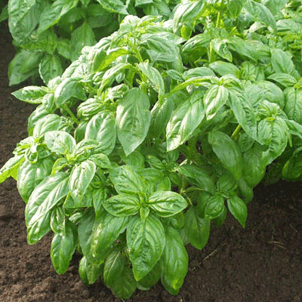
Type: Seed (annual, freely seeding)
Sun Requirements: Full sun
Best Planting Time: After the last confirmed spring frost
Important Characteristic: Loses intensity of taste if allowed to bloom; flowers attract bees; aromatic scent may repel aphids, yet aphids are a known pest
Attracts: Bees
Repels: Tomato hornworms, flies, aphids, mosquitoes, white flies and cabbage worms
Pests: Aphids, Japanese beetles
Companion Plants: – FAVORABLE – Tomatoes, oregano, peppers, marigolds, carrots, and parsley – UNFAVORABLE – Rue and sage
Soil Benefits: N/A
Basil can be planted outdoors after the last confirmed spring frost, but you can get a nice head start if you start seedlings indoors, approximately 5-6 weeks prior to the last spring frost. Considering this plant favors warm, sunny weather, having strong transplants ready to move at this time can be nice. You want to ensure that the soil temperature is above 70 degrees for best plant health. Make sure the soil is moist and has good drainage.
If companion planting with tomatoes, place 2-3 basil plants for every 1 tomato plant. Basil and tomato plants get along quite nicely and basil helps repel tomato hornworms. In addition, it is said that basil will help the growth and flavor of tomatoes. Considering basil is also reputed to repel flies and mosquitoes, having a small dish with minced basil near picnic table food or patio spreads is always a good idea. Combined the minced basil with a dish of sliced tomatoes for a tasty repellent.
Some folks will advise mulching your basil plants to keep the soil moist during the hot summer months. Me, I say heap some compost on them! Compost serves two purposes when used this way: 1) it helps keeps moisture in the ground, so you can water less, and the microbes in your soil stay alive and active and; 2) it is a great way to work fertile, organic matter back into your soil naturally. So my advice is to always use compost in your garden instead of mulch.
Now, as important as what I’ve mentioned above is how to MAINTAIN your basil plants. For the most part, basil can be ignored, so long as you have some fertile soil and you keep it watered. But, if you want big bushy basil plants, you MUST prune them methodically. Basil plants all put out leaves in pairs, generally on the opposite side of the sprouting stem. If you prune the stem about an inch above where the leaves are sprouting, those leaves will grow into branches. Subsequently, those branches will also sprout opposing leaves. Repeat the process several times and the spindly basil plant will grow int a bush.
Basil plants are also heavy seeders. Unfortunately, basil loses the sharpness of it’s flavor if allowed to fully bloom. So, until you are ready for it to go to seed, pinch off the bloom nubbies early, and ensure that it does not bloom. At the end of the season, which for us down here in the south is close to early November, allow the plant to bloom and go to seed. I generally collect half the seed and let the other half fall to the ground. I also take the plant stalks and plop those into the compost bin.
Enjoy your basil plants!

